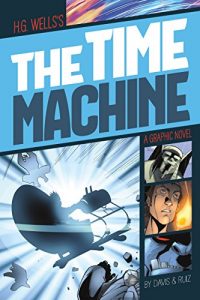 The Time Machine (Graphic Novel Retelling)
The Time Machine (Graphic Novel Retelling)
Retold by Terry Davis
Illustrated by José Alfonso Ocampo Ruiz
Stone Arch Books
Published on September 1, 2007
Amazon | Barnes & Noble | Goodreads
About the Original Story, The Time Machine by H. G. Wells
So begins the Time Traveller’s astonishing firsthand account of his journey 800,000 years beyond his own era—and the story that launched H.G. Wells’s successful career and earned him his reputation as the father of science fiction. With a speculative leap that still fires the imagination, Wells sends his brave explorer to face a future burdened with our greatest hopes…and our darkest fears. A pull of the Time Machine’s lever propels him to the age of a slowly dying Earth.
There he discovers two bizarre races—the ethereal Eloi and the subterranean Morlocks—who not only symbolize the duality of human nature, but offer a terrifying portrait of the men of tomorrow as well. Published in 1895, this masterpiece of invention captivated readers on the threshold of a new century. Thanks to Wells’s expert storytelling and provocative insight, The Time Machine will continue to enthrall readers for generations to come.
My Review of The Time Machine Graphic Novel Adaptation
I should first confess that I read the graphic novel adaptation before actually going back and reading the original version of the story. I’m not sure if that colors my review or not, but that’s the way it happened.
The classic version of course is a lot meatier than the graphic novel version. I definitely think younger or reluctant readers would prefer the graphic novel for its simplicity and streamlined storytelling. I was impressed by how much of the tale is conveyed through the illustrations themselves—they really capture a sense of action and intensity far beyond what I expected from still images, if that makes sense.
The graphic novel version definitely loses a lot of the nuance and complexity of the original story. A lot of the inner workings of the Time Traveler’s thoughts simply don’t appear in the graphic novel version, which I feel like is a significant loss, since that’s what gave the story so much depth. The graphic novel also glosses over what happens to the character Weena, which I found sad. It’s also worth noting that the illustrations show the Eloi as darker skinned people. The original describes them as pale and fair. (Not a bad thing, just a difference I noticed.)
Younger readers looking to explore the science fiction genre may find this to be a perfect entry point as the story is accessible and action-packed, though spare in its telling.
 Recommended for Ages 8 to 12 for the graphic novel version. The original story is better suited to readers 12 and up.
Recommended for Ages 8 to 12 for the graphic novel version. The original story is better suited to readers 12 and up.
Cultural Elements
The original story describes all characters as white. The graphic novel depicts the Eloi as darker-skinned people.
Profanity/Crude Language Content
None.
Romance/Sexual Content
None.
Spiritual Content
None.
Violent Content
In the original story, the Time Traveler has to fight through many enemies who try to paw at him and capture him. He kills some and wounds others, though the descriptions are brief.
In both stories, he learns of a group that eats humans.
Drug Content
None.
 Note: I received a free copy of this book in exchange for my honest review.
Note: I received a free copy of this book in exchange for my honest review.






 The Time Machine (Graphic Novel Retelling)
The Time Machine (Graphic Novel Retelling)







